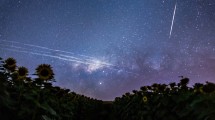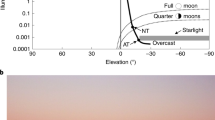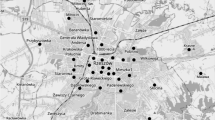Abstract
The rising population of artificial satellites and associated debris in low-altitude orbits is increasing the overall brightness of the night sky, threatening ground-based astronomy as well as a diversity of stakeholders and ecosystems reliant on dark skies. We present calculations of the potentially large rise in global sky brightness from space objects in low Earth orbit, including qualitative and quantitative assessments of how professional astronomy may be affected. Debris proliferation is of special concern: we calculate that all log-decades in debris size contribute approximately the same amount of night sky radiance, so debris-generating events are expected to lead to a rapid rise in night sky brightness along with serious collision risks for satellites from centimetre-sized objects. This increase in low-Earth-orbit traffic will lead to loss of astronomical data and diminish opportunities for ground-based discoveries as faint astrophysical signals become increasingly lost in the noise. Lastly, we discuss the broader consequences of brighter skies for a range of sky constituencies, equity/inclusion and accessibility for Earth- and space-based science, and cultural sky traditions. Space and dark skies represent an intangible heritage that deserves intentional preservation and safeguarding for future generations.
This is a preview of subscription content, access via your institution
Access options
Access Nature and 54 other Nature Portfolio journals
Get Nature+, our best-value online-access subscription
$32.99 / 30 days
cancel any time
Subscribe to this journal
Receive 12 digital issues and online access to articles
$119.00 per year
only $9.92 per issue
Buy this article
- Purchase on SpringerLink
- Instant access to full article PDF
Prices may be subject to local taxes which are calculated during checkout


Similar content being viewed by others
References
Lawrence, A. et al. The case for space environmentalism. Nat. Astron. 6, 428–435 (2022).
Walker, C. et al. Impact of Satellite Constellations on Optical Astronomy and Recommendations Toward Mitigations (NOIRLab, NSF, 2020); https://aas.org/sites/default/files/2020-08/SATCON1-Report.pdf
Walker, C. et al. Dark and Quiet Skies for Science and Society (International Astronomical Union, 2020); https://www.iau.org/static/publications/dqskies-book-29-12-20.pdf
Hall, J. et al. Report of the SATCON2 Workshop 12-16 July 2021: Executive Summary (NOIRLab, NSF, 2021); https://noirlab.edu/public/media/archives/techdocs/pdf/techdoc031.pdf
Walker, C. & Benvenuti, P. (eds) Dark and Quiet Skies for Science and Society II: Working Group Reports (NOIRLab, NSF, 2022); https://noirlab.edu/public/media/archives/techdocs/pdf/techdoc021.pdf
Rawls, M. & Bektešević, D. Trailblazer (International Astronomical Union Centre for the Protection of the Dark and Quiet Sky from Satellite Constellation Interference, 2022); https://trailblazer.dirac.dev/
McDowell, J. The low earth orbit satellite population and impacts of the SpaceX Starlink constellation. Astrophys. J. 892, L36 (2020).
Hainaut, O. & Williams, A. Impact of satellite constellations on astronomical observations with ESO telescopes in the visible and infrared domains. Astron. Astrophys. 636, A121 (2020).
Ragazzoni, R. The surface brightness of megaconstellation satellite trails on large telescopes. Publ. Astron. Soc. Pac. 132, 114502 (2020).
Mróz, P. et al. Impact of the SpaceX Starlink satellites on the Zwicky Transient Facility Survey observations. Astrophys. J. Lett. 924, L30 (2022).
Lawler, S., Boley, A. & Rein, H. Visibility predictions for near-future satellite megaconstellations: latitudes near 50° will experience the worst light pollution. Astron. J. 163, 21 (2021).
Kocifaj, M., Kundracik, F., Barentine, J. & Bará, S. The proliferation of space objects is a rapidly increasing source of artificial night sky brightness. Mon. Not. R. Astron. Soc. Lett. 504, L40–L44 (2021).
Bassa, C., Hainaut, O. & Galadí-Enríquez, D. Analytical simulations of the effect of satellite constellations on optical and near-infrared observations. Astron. Astrophys. 657, A75 (2022).
Space Environment Report (European Space Agency, 2022); https://sdup.esoc.esa.int/discosweb/statistics/
Yap, X.-S. & Truffer, B. Contouring ‘earth-space sustainability’. Environ. Innov. Soc. Transit. 44, 185–193 (2022).
Kruk, S. et al. The impact of satellite trails on Hubble Space Telescope observations. In From Measurements to Understanding: MASTER Modelling Workshop2–4 March 2021 (eds Oikonomidou, X. et al.) (European Space Agency, 2021); https://indico.esa.int/event/370/contributions/5925/attachments/4238/6337/Sandor_Kruk_The_impact_of_satellite_trails_on_Hubble_observations_compressed.pdf
Tyson, J. A. et al. Mitigation of LEO satellite brightness and trail effects on the Rubin Observatory LSST. Astron. J. 160, 226 (2020).
Hasan, I., Tyson, J. A., Saunders, C., & Xin, B. Mitigating satellite trails: A study of residual light after masking. Astron. Comput. 39, 100584 (2022).
Green, R., Luginbuhl, C., Wainscoat, R. & Duriscoe, D. The growing threat of light pollution to ground-based observatories. Astron. Astrophys. Rev. 30, 1 (2022).
Falchi, F. et al. Light pollution indicators for all the major astronomical observatories. Mon. Not. R. Astron. Soc. 519, 26–33 (2022).
Borovička, J. et al. The trajectory, structure and origin of the Chelyabinsk asteroidal impactor. Nature 503, 235–237 (2013).
Impact of Satellite Constellations (Vera Rubin Observatory, 2022); https://www.lsst.org/content/lsst-statement-regarding-increased-deployment-satellite-constellations
Jiang, L. et al. A possible bright ultraviolet flash from a galaxy at redshift z ≈ 11. Nat. Astron. 5, 262–267 (2020).
Nir, G., Ofek, E. & Gal-Yam, A. The GN-z11-flash event can be a satellite glint. Res. Not. Am. Astron. Soc. 5, 27 (2021).
Michałowski, M., Kamiński, K., Kamińska, M. & Wnuk, E. GN-z11-flash from a man-made satellite not a gamma-ray burst at redshift 11. Nat. Astron. 5, 995–997 (2021).
Ivezić, Ž. et al. LSST: from science drivers to reference design and anticipated data products. Astrophys. J. 873, 111 (2019).
Sternberg, J. & Ingham, M. Observations of the airglow continuum. Mon. Not. R. Astron. Soc. 159, 1–20 (1972).
NSF FY 2021 Budget Request to Congress (NSF, 2020); https://nsf.gov/about/budget/fy2021/pdf/34g_fy2021.pdf
Muntoni, G., Montisci, G., Pisanu, T., Andronico, P. & Valente, G. Crowded space: a review on radar measurements for space debris monitoring and tracking. Appl. Sci. 11, 1364 (2021).
Mandeville, J. & Berthoud, L. From LDEF to EURECA: orbital debris and meteoroids in low earth orbit. Adv. Space Res. 16, 67–72 (1995).
Le May, S., Gehly, S., Carter, B. & Flegel, S. Space debris collision probability analysis for proposed global broadband constellations. Acta Astronaut. 151, 445–455 (2018).
Mallama, A. A bidirectional reflectance distribution function for VisorSat calibrated with 10,628 magnitudes from the MMT-9 database. Preprint at https://arxiv.org/abs/2109.07345 (2021).
Tregloan-Reed, J. et al. Optical-to-NIR magnitude measurements of the Starlink LEO darksat satellite and effectiveness of the darkening treatment. Astron. Astrophys. 647, A54 (2021).
Mallama, A., Cole, R., Harrington, S. & Maley, P. Visual magnitude of the BlueWalker 3 satellite. Preprint at https://arxiv.org/abs/2211.09811 (2022).
McDowell, J. Enormous (‘mega’) satellite constellations. Jonathan’s Space Report https://planet4589.org/space/con/conlist.html (2023).
Barentine, J. Night sky brightness measurement, quality assessment and monitoring. Nat. Astron. 6, 1120–1132 (2022).
Ruggles, C. Astronomy and world heritage. Proc. Int. Astron. Union 6, 12–17 (2010).
Venkatesan, A., Lowenthal, J., Prem, P. & Vidaurri, M. The impact of satellite constellations on space as an ancestral global commons. Nat. Astron. 4, 1043–1048 (2020).
Gullberg, S. et al. A cultural comparison of the ‘dark constellations’ in the Milky Way. J. Astron. Hist. Herit. 23, 390–404 (2020).
Lee, A. et al. Indigenous astronomy: best practices and protocols for including Indigenous astronomy in the planetarium setting. In Proceedings of the 25th International Planetarium Society Conference 3-7 August 2020 (ed. Smith, D. W.) 69–77. (International Planetarium Society, 2020) https://cdn.ymaws.com/www.ips-planetarium.org/resource/resmgr/vcon2020/papers/IPS_2020.pdf
Venkatesan, A. et al. in SATCON2 Working Group Reports (eds Hall, J. & Walker, C) 102 (NOIRLab, 2021).
Nadybal, S., Collins, T. & Grineski, S. Light pollution inequities in the continental United States: adistributive environmental justice analysis. Environ. Res. 189, 109959 (2020).
Foster, J., Smolka, J., Nilsson, D.-E. & Dacke, M. How animals follow the stars. Proc. R. Soc. B 285, 20172322 (2018).
Stone, E., Harris, S. & Jones, G. Impacts of artificial lighting on bats: a review of challenges and solutions. Mamm. Biol. 80, 213–219 (2015).
Pakhomov, A., Anashina, A. & Chernetsov, N. Further evidence of a time-independent stellar compass in a night-migrating songbird. Behav. Ecol. Sociobiol. 71, 48 (2017).
Patrick, S., Grissom, J., Woods, S. & Newsome, U. Broadband access, district policy, and student opportunities for remote learning during COVID-19 school closures. AERA Open 7, 233285842110642 (2021).
Rawls, M. et al. Satellite constellation internet affordability and need. Res. Notes Am. Astron. Soc. 4, 189 (2020).
Massey, R., Lucatello, S. & Benvenuti, P. The challenge of satellite megaconstellations. Nat. Astron. 4, 1022–1023 (2020).
Lalbakhsh, A. et al. Darkening low-Earth orbit satellite constellations: a review. IEEE Access 10, 24383–24394 (2022).
Cole, R. Measurement of the brightness of the Starlink spacecraft named ‘DARKSAT’. Res. Notes Am. Astron. Soc. 4, 42 (2020).
Tregloan-Reed, J. et al. First observations and magnitude measurement of Starlink’s Darksat. Astron. Astrophys. 637, L1 (2020).
Mallama, A. Starlink satellite brightness—characterized from 100,000 visible light magnitudes. Preprint at https://arxiv.org/abs/2111.09735 (2021).
Cole, R. A sky brightness model for the Starlink ‘Visorsat’ spacecraft. Res. Notes Am. Astron. Soc. 4, 182 (2020).
Horiuchi, T., Hanayama, H. & Ohishi, M. Simultaneous multicolor observations of Starlink’s Darksat by the Murikabushi Telescope with MITSuME. Astrophys. J. 905, 3 (2020).
Brightness Mitigation Best Practices for Satellite Operators (SpaceX, 2022); https://api.starlink.com/public-files/BrightnessMitigationBestPracticesSatelliteOperators.pdf
Byers, M., Wright, E., Boley, A. & Byers, C. Unnecessary risks created by uncontrolled rocket reentries. Nat. Astron. 6, 1093–1097 (2022).
Space Innovation IB Docket No. 22-271 Mitigation of Orbital Debris in the New Space Age IB Docket No. 18-313 (Federal Communications Commission, 2022); https://www.fcc.gov/document/fcc-adopts-new-5-year-rule-deorbiting-satellites-0
Shan, M., Guo, J. & Gill, E. Review and comparison of active space debris capturing and removal methods. Prog. Aerosp. Sci. 80, 18–32 (2016).
Mark, C. & Kamath, S. Review of active space debris removal methods. Space Policy 47, 194–206 (2019).
Rybus, T. Obstacle avoidance in space robotics: review of major challenges and proposed solutions. Prog. Aerosp. Sci. 101, 31–48 (2018).
Lewis, H. Understanding long-term orbital debris population dynamics. J. Space Saf. Eng. 7, 164–170 (2020).
Silk, J., Crawford, I., Elvis, M. & Zarnecki, J. Astronomy from the Moon: the next decades. Phil. Trans. R. Soc. A 379, 20190560 (2020).
Spudis, P. in Toward a Theory of Spacepower (eds Lutes, C. D. & Hays, P. L.) 241–251 (Institute For National Strategic Studies, National Defense Univ. Press, 2011).
Crumey, A. Human contrast threshold and astronomical visibility. Mon. Not. R. Astron. Soc. 442, 2600–2619 (2014).
Bortle, J. Introducing the Bortle Dark-Sky Scale. Sky Telescope 101, 126–129 (2001).
Acknowledgements
M.K. acknowledges support from the Slovak Research and Development Agency under contract number APVV-18-0014. A.V. gratefully acknowledges support from the University of San Francisco Faculty Development Fund. The views expressed in this Perspective do not necessarily represent the positions of either the American Astronomical Society or the International Astronomical Union.
Author information
Authors and Affiliations
Corresponding author
Ethics declarations
Competing interests
J.C.B., A.V., J.H. and J.L. are unpaid members of committees of the American Astronomical Society and International Astronomical Union, whose scopes of concern include the topics covered by this Perspective.
Peer review
Peer review information
Nature Astronomy thanks Piero Benvenuti and the other, anonymous, reviewer(s) for their contribution to the peer review of this work.
Additional information
Publisher’s note Springer Nature remains neutral with regard to jurisdictional claims in published maps and institutional affiliations.
Rights and permissions
Springer Nature or its licensor (e.g. a society or other partner) holds exclusive rights to this article under a publishing agreement with the author(s) or other rightsholder(s); author self-archiving of the accepted manuscript version of this article is solely governed by the terms of such publishing agreement and applicable law.
About this article
Cite this article
Barentine, J.C., Venkatesan, A., Heim, J. et al. Aggregate effects of proliferating low-Earth-orbit objects and implications for astronomical data lost in the noise. Nat Astron 7, 252–258 (2023). https://doi.org/10.1038/s41550-023-01904-2
Received:
Accepted:
Published:
Issue date:
DOI: https://doi.org/10.1038/s41550-023-01904-2
This article is cited by
-
Sustainable Development Goals relighted: light pollution management as a novel lens to SDG achievement
Discover Sustainability (2025)
-
The high optical brightness of the BlueWalker 3 satellite
Nature (2023)



